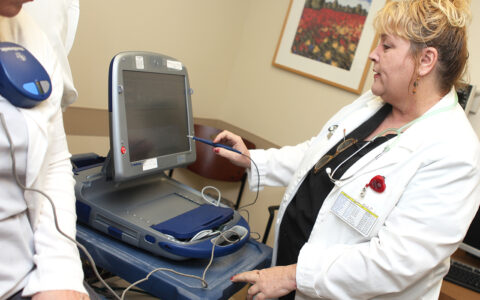A medial branch block (MBB) may be an imperfect tool, but it is still the best way to discern whether a patient’s lumbar back pain is due to osteoarthritis – and therefore treatable by radiofrequency neurotomy (RFN) – or whether they have an injured disk or other pathology not helped by RFN.
A first positive medial branch block (MBB1) followed by a second one (MBB2) meets most insurance requirements for use of RFN. Yet, the extra step of ordering a second procedure has become a source of controversy among many spine interventionalists.
At Vanderbilt University Medical Center, Byron J. Schneider, M.D., an associate professor of physical medicine and rehabilitation, believes that the disagreement is unhealthy for patient care and may ultimately carve a path away from reimbursement for the constellation of spinal injections now approved.
In a new retrospective review, Schneider and coauthors examine progression to RFN in Vanderbilt patients receiving MBB1 and MBB2, per protocol, to learn how many patients would have had unnecessary ablations if they had progressed directly to RFN after a positive MBB1 alone.
“The argument is over whether it is better to reduce the overall number procedures by doing RNF on the full spectrum of patients with a positive MBB or take the additional step of doing a second MBB and avoid putting patients who wouldn’t benefit through a more substantial procedure,” Schneider said.
Dual Branch Block Favored
Between 15 and 45 percent of lumbar back pain is attributable to zygapophysial joint osteoarthritis. For these patients, the pain is often treatable with RFN, which ablates afferent nerves that relay pain signals to the brain. These ablations, while generally safe, are not without a downside. The injection is made with a large needle, there is impairment of some small muscles in the back, and a small risk of collateral nerve damage also exists.
“RFN is a significant procedure that won’t help that 70 percent or so of patients, whose back pain comes from etiologies other than osteoarthritis,” Schneider said.
Both MBB1 and MBB2 are filters for winnowing out those who will not benefit from RFN. The Spine Intervention Society endorses a dual block paradigm, with only patients who experience at least 80 percent pain relief after MBB1 proceeding to MBB2, with the same threshold needed at MBB2 to proceed to RFN. In 2020, Schneider and colleagues demonstrated that this patient selection paradigm results in a significantly higher percent of treated patients achieving pain relief than when patients proceed directly from a positive MBB1 to RFN.
Yet no prior studies have retrospectively audited clinical practice to see how much this dual block paradigm reduces the number of patients who ultimately receive ablation. This was the gap in knowledge Schneider and his team sought to fill.
“This gives us more solid evidence of the dual block method’s value in minimizing the chance that you will ablate someone with a false positive.”
False Positives May Occur
To find answers, Schneider and his team examined records on 167 patients who underwent dual lumbar MBBs in 2019. Of these, 90 (54 percent) progressed from MBB1 to MBB2, but only 66 (40 percent) had a positive MBB2 that cleared them for RFN. Twenty-four patients (14 percent), therefore, had a false positive on their initial MBB1 and were screened out after the second MBB2.
“For all my patients, the more research we have, the better I can lay out the projected outcomes, and help avoid desperation trumping reality.”
These statistics mirrored Schneider’s findings for cervical branch blocks, where he found that a dual block saved about 15 percent of patients from ineffective, inappropriate ablations.
“This gives us more solid evidence of the dual block method’s value in minimizing the chance that you will ablate someone with a false positive,” Schneider said.
Having this data may help clinicians in counseling their patients, some of whom Schneider says can be single-mindedly focused on getting an ablation, sometimes misrepresenting their improvement after MBB, or experiencing the placebo effect.
“My best patient is one who wants to be thorough and only do things that have a high likelihood of success,” Schneider said, “but for all my patients, the more research we have, the better I can lay out the projected outcomes, and help avoid desperation trumping reality.”
Avoiding a Reimbursement Gamble
Judicious patient selection may also be in the best interest of interventional pain specialists.
Schneider says that the exponential growth in back and neck pain procedures over the past few decades has subjected the field to more scrutiny, already resulting in decreased third-party reimbursement for these procedures.
“Physicians who take the shortcut are going to do more ablations than I will, and will probably have as many successes,” Schneider said. “But they will also have more failures.
“Ultimately, I think showing that we are cautious in making these ablation decisions will pay off for everyone in terms of higher success rates and less reimbursement hassles. We need to keep doing this the right way so we can keep doing it.”





